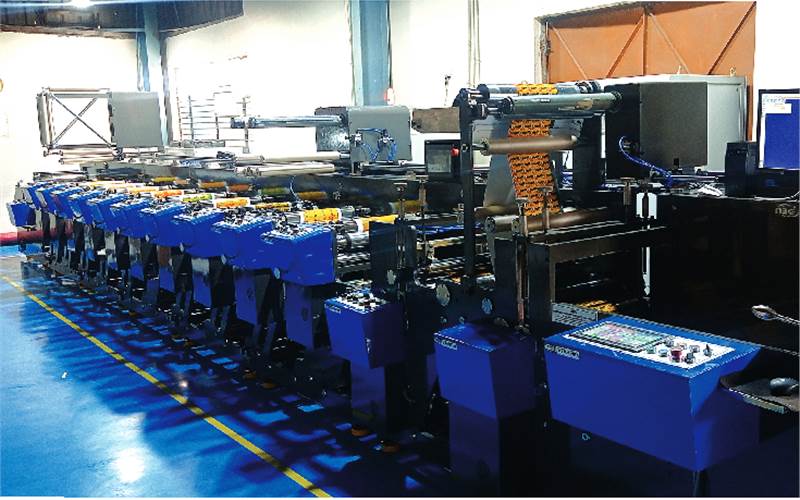StarFlex from NBG Printographic Machinery
Nitin Garg, director of NBG Printographic Machinery, introduces StarFlex - an inline rotary flexo press with servo-drive controls. "StarFlex was launched in 2022 and is designed for converters who are in producing labels, flexible packaging, in-mould labels and tags." Rahul Kumar reports
02 Aug 2023 | By Rahul Kumar
The StarFlex by NBG Printographic Machinery, an inline rotary flexo printing machine with servo-drive controls, is a sophisticated piece of equipment that combines advanced technology and a robust structure to achieve high-quality printing results.
Nitin Garg, director, NBG Printographic Machinery, says that by employing the latest technology and controls, the machine enables high-speed, precise, and consistent printing of various products.
“It offers flexibility in terms of substrate compatibility, allowing for the production of labels, flexible packaging, thermal stationery, tags, IML, and more. The combination of advanced technology, accurate ink application, and substrate handling capabilities ensures superior print quality, vibrant colours, and excellent registration, meeting the print needs of different industries,” Garg says.
He adds, “With over 35 years of industry experience, NBG Printographic Machinery takes great pride in offering StarFlex, a meticulously engineered flexo printing machine. This kit is a testament to our commitment to excellence.”
Wide range of uses
StarFlex, which was launched in 2022, is designed for converters who specialise in producing labels, flexible packaging, in-mould labels, tags, and other related products.
The StarFlex is ideal for industries such as pharmaceuticals, food and beverage, FMCG, wine and spirits, and more. It produces labels with precise registration and vibrant colours. It's perfect for printing on flexible substrates, IML production, and different tag materials, as well as thermal paper for receipts and labels.
Most suitable for India
Garg says the pricing strategy and localisation of the machine to suit the Indian market make it highly suitable for an extremely price-sensitive market like India. "The machine is priced to align with the cost-conscious nature of the Indian market." He adds, "Offering a competitive price point makes it more accessible and attractive to printers operating within budget constraints."
The machine's advanced servo-drive controls and modular construction contribute to its cost-efficiency. "These features optimise production processes, reduce waste, and enhance productivity, ultimately providing a favourable return on investment for printers," he adds.
Garg explains that the machine is made in India, further strengthening its suitability for the market. "Localisation brings several benefits, including reduced import costs, shorter lead times, and improved after-sales support. It also promotes the growth of the local manufacturing sector and contributes to the country's economic development," he says.
The machine's ability to handle a wide range of substrates and integrate with various printing systems enhances its versatility. This adaptability allows Indian printers to cater to diverse customer demands, expand their offerings, and explore new markets without the need for multiple specialised machines.
The availability of local service and support networks is crucial in price-sensitive markets. With the machine's localisation, it becomes easier to access technical assistance, spare parts, and maintenance services, ensuring minimal downtime and uninterrupted production.
"The machine's sturdy structure and robust construction contribute to its reliability and durability. This minimises downtime due to machine failures or breakdowns, ensuring uninterrupted production and timely delivery of orders. Reduced maintenance requirements and longevity of the machine's components enhance the cost-effectiveness for customers," he explains.
The USPs
Garg says the machine offers versatility in terms of substrate compatibility, accommodating a range of materials from films to boards. It also has the capability to integrate with other printing systems like offset, gravure, rotary screen, and digital, allowing for customisation and flexibility in meeting diverse printing needs.
“The machine offers the unique advantage of integrating multiple printing systems. It can incorporate other printing technologies like offset, gravure, rotary screen, and digital. By combining different printing systems into a single machine, customers gain the flexibility to adapt to different printing requirements and explore new market opportunities,” he says. For example, a customer can combine flexo printing for labels with offset printing for packaging cartons, all within a single machine.
Another unique characteristic of the machine is its modular construction for flexibility. It allows for easy assembly, disassembly, and maintenance. This modularity enhances flexibility in adapting the machine to specific production needs or making modifications as required. For instance, a customer may need to expand the printing width or incorporate additional units for specific applications. The modular design enables such modifications, ensuring the machine remains versatile and adaptable to evolving printing demands.
The tool-less ink tray loading allows operators to load and unload ink trays without the need for tools or complicated adjustments.
Also, by customising the machine’s match tooling with their existing machines, the company provides a cost-effective solution that reduces tool library expenses. “Customers can utilise their existing tooling, eliminating the need to invest in new tools. This results in significant cost savings,” Garg says.
The productivity
Garg says the machine has been designed to perform at high speeds with faster setting time and lower wastage. “We have tested the machine at full production speed at 150 m/min for MLS and 200 m/min for ELS.
“The machine has been developed with easy-to-operate features where many of our customers are able to train new operators in less than two weeks,” he says, adding, “We provide in-depth training on the operation of the StarFlex machine, including its control panel, HMI interface, and servo-drive system,” he says.
The market
NBG has installed five StarFlex machines since its launch, three in India and two overseas. Garg says the company has a good number of orders in the pipeline, and the numbers will increase in the coming years.
“StarFlex represents the culmination of our extensive expertise and technological advancements. With its advanced servo-drive controls, modular construction, and exceptional versatility, this machine sets new benchmarks in the industry. It is engineered to deliver exceptional performance, reliability, and precision for a wide range of applications. StarFlex is a perfect alternative to European and American machines,” Garg concludes.












 See All
See All